Coat of arms of Puerto Rico
The coat of arms of Puerto Rico was first granted by the Spanish Crown in 1511, making it the oldest heraldic achievement still currently in use in the Americas.[1] The territory was ceded by Spain to the United States in accordance to the peace treaty that ended the Spanish–American War in 1899, after which two interim arms were adopted briefly. A law was passed in 1905 that re-established the historical armorial bearings as the arms of the territory; after numerous investigations and amendments, the current version was adopted in 1976.
| Coat of Arms of Puerto Rico | |
|---|---|
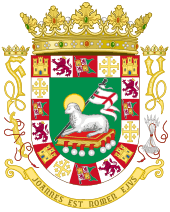 | |
| Versions | |
.svg.png) Variant | |
| Armiger | Estado Libre Asociado de Puerto Rico (Commonwealth of Puerto Rico) |
| Adopted | 1976 (1511 & 1905) |
| Motto | Joannes Est Nomen Ejus, Latin "John is his name". |
History

The major symbolism of the coat of arms relates to the dominance of Spain, the strong Roman Catholic influence in the region, and the integrity of Puerto Rico as a colony of Spain. There have been different variations of the coat of arms changing throughout Puerto Rico's history. The current version was officially re-adopted by the government of Puerto Rico on 3 June 1976.
On the shield:
- The green background represents the island's vegetation. The Lamb of God and cross flag on the shield are symbols traditionally associated with St. John the Baptist, patron of the island. The book with the seven seals on which the lamb sits represents symbolism from the Book of Revelation, generally attributed to St. John the Apostle.
- The border is made up of 16 different elements: castles and lions to represent the Kingdom of Castile and the Kingdom of León, a flag with the arms of the Crown of Castile and León, and The Cross of Jerusalem to stand for the Kingdom of Jerusalem, whose succession rights passed to the Kingdom of Sicily, and henceforth to the Spanish Crown.
- The gold-crowned F and the arrows (Spanish: flechas) represent Ferdinand II of Aragon, while the Y and the yoke (Spanish: yugo) represent Ysabel, i.e., Isabella I of Castile who were the Catholic monarchs when Puerto Rico was discovered.[2] It is said, that the "I" on the shield, was in fact a "J" representing Queen "Joanna", commonly known as "Juana La Loca", daughter, and successor of Queen Isabella after she allegedly became mentally ill after the death of her husband, and in whose name her father, as regent of Spain granted the coat of arms to the Spanish territory of San Juan, as Puerto Rico was then known.
- The Latin motto, "JOANNES EST NOMEN EJUS" (a quotation from the Vulgate of Luke 1:63), means "John is his name", referring to St. John the Baptist or San Juan Bautista, the original Spanish name of the island.[3]
Great Seal
| Great Seal of Puerto Rico | |
|---|---|
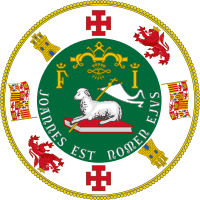 | |
| Armiger | Estado Libre Asociado de Puerto Rico (Commonwealth of Puerto Rico) |
| Motto | Joannes Est Nomen Ejus, Latin "John is his name". |
All of the states and territories of the United States employ a seal to authenticate and ratify documents and accordingly a seal of Puerto Rico exists, but the traditional coat of arms is used as the main emblem of the territory. The seal has most of the elements of the coat of arms, but the religious elements have been stripped away in accordance with the Separation of church and state in the United States. In the seal, the lamb, which no longer has a halo, carries a white banner instead of one with a Red Cross. The book the lamb sits on does not have the seals of the Book of Revelation. The first Governors used the seal as their emblem but in recent years the usage of the seal has been limited to being the official emblem used to represent Puerto Rico on its legal documents when they are sealed.
Seal of the Governor
The Seal of the Governor is the official symbol of the executive head of Puerto Rico. It follows the design used by the Seal of the President of the United States. There are several variants of the Governor's Seal in use.
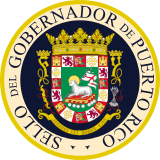 Seal of the Governor of Puerto Rico
Seal of the Governor of Puerto Rico.svg.png) A variant of the Governor's seal
A variant of the Governor's seal Seal of the Governor Elect
Seal of the Governor Elect
Seals of the government of Puerto Rico
There are several seals of the different sections of the Puerto Rican government.
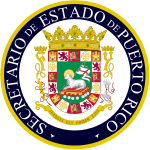 Seal of the Secretary of State of Puerto Rico
Seal of the Secretary of State of Puerto Rico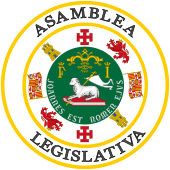 Seal of the Legislative Assembly of Puerto Rico
Seal of the Legislative Assembly of Puerto Rico Seal of the House of Representatives of Puerto Rico
Seal of the House of Representatives of Puerto Rico Seal of the Senate of Puerto Rico
Seal of the Senate of Puerto Rico.svg.png) A variant of the seal of the Senate
A variant of the seal of the Senate
See also
- Flag of Puerto Rico
- Castile and Leon
- Spanish heraldry
- Coat of arms
- Heraldry
References
- New York Daily News, June 3, 2008.
- s/Escudo.htm Official Puerto Ricao Government website.]
- Grabowski, John F. (1992). U.S. Territories and Possessions (State Report Series). Chelsea House Pub. Page 7. ISBN 9780791010532.
.svg.png)
